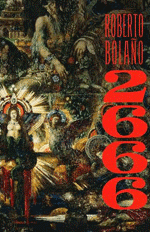Angrama Press (2004)/ Farrar, Strauss and Giroux (2008)
Review by Matt Pincus
2666, Bolaño’s last novel, which could easily be seen as five interconnected novels, is a literary classic in a young century. It is extremely rare for a Latin American – or any international author – to be translated into English, published and distributed by a major house like FSG. The almost nine hundred pages are well worth a reader’s time, as the narrator takes an underlying lucidness to the prose that builds on itself through plot inconsistencies. Bolaño knows our genre expectations as reader, and carries one on those expectations, only to continually create gaps where a “fiction-making system” is created, as translator and scholar Chris Andrews says. 2666 opens old wounds of history in the land, and exposes the trauma of a community governed by evil.
The text is separated into five parts, and each of these sections has a separate genre: academic satire, thriller, detective fiction, beat novel, and historical romance. They all center on the town of Santa Teresa, a fictional border-city in Mexico, much like Ciudad Juárez. The academics come to the city to find Benno Von Archimboldi, the writer, who is nowhere to be found. Amalfitano, a professor at the university, is hanging geometric figures on his clothesline, delving into philosophical digressions as his daughter goes in and out of the house. Fate is an African American reporter from New York sent for an article about a boxing match when he starts to learn about the murders of women in the city. Continue reading
![[PANK]](https://pankmagazine.com/wp-content/themes/pank/assets/images/pank-logo-large.png)

